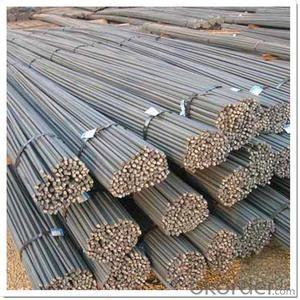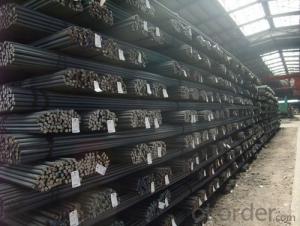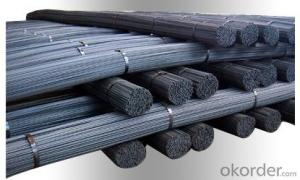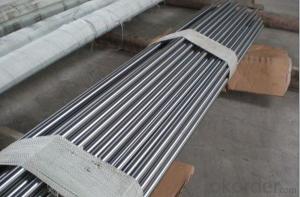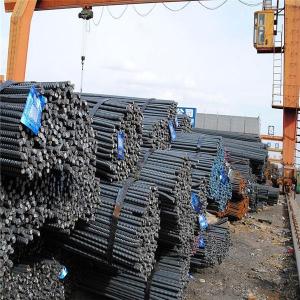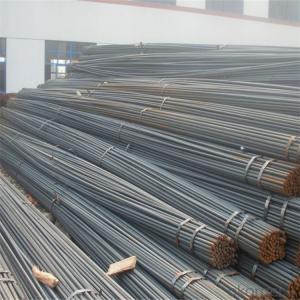Steel Ribbed Rebar HRB400
- Loading Port:
- China Main Port
- Payment Terms:
- TT OR LC
- Min Order Qty:
- -
- Supply Capability:
- -
OKorder Service Pledge
OKorder Financial Service
You Might Also Like
Chemical Composition: (Please kindly find our chemistry of our material based on HRB500 as below for your information)
Grade | Technical data of the original chemical composition (%) | ||||||
C | Mn | Si | S | P | V | ||
HRB400 | ≤0.25 | ≤1.60 | ≤0.80 | ≤0.045 | ≤0.045 | 0.04-0.12 | |
Physical capability | |||||||
Yield Strength (N/cm²) | Tensile Strength (N/cm²) | Elongation (%) | |||||
≥400 | ≥570 | ≥14 | |||||
Theoretical weight and section area of each diameter as below for your information:
Diameter(mm) | Section area (mm²) | Mass(kg/m) | Weight of 12m bar(kg) |
6 | 28.27 | 0.222 | 2.664 |
8 | 50.27 | 0.395 | 4.74 |
10 | 78.54 | 0.617 | 7.404 |
12 | 113.1 | 0.888 | 10.656 |
14 | 153.9 | 1.21 | 14.52 |
16 | 201.1 | 1.58 | 18.96 |
18 | 254.5 | 2.00 | 24 |
20 | 314.2 | 2.47 | 29.64 |
22 | 380.1 | 2.98 | 35.76 |
25 | 490.9 | 3.85 | 46.2 |
28 | 615.8 | 4.83 | 57.96 |
32 | 804.2 | 6.31 | 75.72 |
36 | 1018 | 7.99 | 98.88 |
40 | 1257 | 9.87 | 118.44 |
50 | 1964 | 15.42 | 185.04 |
Usage and Applications of HRB400 Deformed Steel Bar:
Deformed bar is widely used in buildings, bridges, roads and other engineering construction. Big to highways, railways, bridges, culverts, tunnels, public facilities such as flood control, dam, small to housing construction, beam, column, wall and the foundation of the plate, deformed bar is an integral structure material. With the development of world economy and the vigorous development of infrastructure construction, real estate, the demand for deformed bar will be larger and larger..
Packaging & Delivery of HRB400 Deformed Steel Bar:
Packaging Detail: products are packed in bundle and then shipped by container or bulk vessel, deformed bar is usually naked strapping delivery, when storing, please pay attention to moisture proof. The performance of rust will produce adverse effect.
- Q: What's the difference between rebar and thread steel?
- Physical and mechanical properties are different. Because of the different chemical composition and strength of reinforcing steel, they are different in physical and mechanical properties. The cold bending property of steel is good, can make the hook 180, screw steel can only make straight hook 90 degrees; steel weldability is good, with ordinary carbon steel electrode can be used to low alloy electrode; anti fatigue performance and toughness in steel bar is good.
- Q: Can steel rebars be used in offshore platform construction?
- Yes, steel rebars can be used in offshore platform construction. Steel rebars are commonly used in the construction of offshore platforms due to their high strength and durability, which is essential for withstanding harsh environmental conditions, including strong waves, corrosive saltwater, and extreme temperatures. Additionally, steel rebars can provide structural reinforcement, ensuring the stability and integrity of the offshore platform throughout its lifespan.
- Q: What is the maximum tensile force of 25 thread steel?
- First of all, to know the brand of thread steel, such as: HRB335, HRB400, HRB500. No matter what the diameter of the thread steel is, the yield strength and tensile strength are the same as for the same grade of thread steel.
- Q: Can steel rebars be used in high-temperature applications?
- Yes, steel rebars can be used in high-temperature applications. Steel rebars have high strength and good thermal stability, allowing them to withstand elevated temperatures without significant deformation or loss of structural integrity. However, it is important to consider the specific grade and composition of the steel rebar, as different types may have varying tolerance levels for high temperatures.
- Q: Can steel rebars be used in structures with high resistance to abrasion?
- Yes, steel rebars can be used in structures with high resistance to abrasion. Steel rebars are commonly utilized in reinforced concrete structures due to their excellent strength and durability. The steel composition and surface treatment of rebars can be optimized to enhance their resistance to abrasion, making them suitable for applications where structures may be exposed to heavy wear and tear.
- Q: What is the role of steel rebars in column and beam construction?
- Steel rebars play a crucial role in column and beam construction as they provide reinforcement and strength to the structure. They are used to enhance the load-bearing capacity, resist tensile forces, and prevent cracking or failure due to external pressures. By reinforcing the concrete, rebars ensure stability, durability, and structural integrity, making them essential components in the construction of columns and beams.
- Q: Can steel rebars be used in structures with high levels of carbonation or acid attack?
- Steel rebars should not be used in structures with high levels of carbonation or acid attack. Carbonation occurs when carbon dioxide from the atmosphere reacts with the alkaline compounds in concrete, resulting in the reduction of the concrete's pH level. This process can lead to the corrosion of steel rebars, as the lower pH levels create an acidic environment that promotes rusting. Similarly, acid attack occurs when structures come into contact with acidic substances, such as industrial chemicals or acid rain. Acidic environments accelerate the corrosion process by further reducing the pH levels of the concrete, increasing the risk of steel rebar deterioration. To prevent these issues, alternative materials like stainless steel, epoxy-coated rebars, or fiber-reinforced polymer rebars can be used in structures exposed to high levels of carbonation or acid attack. These materials have enhanced corrosion resistance properties, providing better durability in challenging environments. It is crucial to consider the specific conditions in which the structure will be exposed and consult with structural engineers to select the most suitable materials for long-term performance and safety.
- Q: Can steel rebars be used in structures with high moisture content in the environment?
- Steel rebars can be used in structures with high moisture content in the environment, but certain precautions need to be taken to prevent corrosion. Moisture can accelerate the corrosion process of steel, leading to structural integrity issues over time. To mitigate this risk, several measures can be implemented. Firstly, the use of corrosion-resistant steel rebars, such as stainless steel rebars, can be considered. These rebars are specifically designed to resist corrosion in high-moisture environments, making them suitable for structures exposed to moisture. Secondly, proper concrete cover thickness should be maintained to protect the rebars from direct contact with moisture. Adequate concrete cover acts as a barrier, preventing moisture from reaching the steel surface and reducing the risk of corrosion. Additionally, the use of waterproofing materials and coatings can be beneficial in preventing moisture ingress into the structure. These materials create a protective layer on the surface of the concrete, preventing water penetration and reducing the likelihood of corrosion. Regular inspection and maintenance are crucial for structures in high-moisture environments. Periodic inspections can help detect any signs of corrosion or damage early on, allowing for timely repairs or preventive measures. In conclusion, while steel rebars can be used in structures with high moisture content, it is important to implement appropriate measures to prevent corrosion. Using corrosion-resistant rebars, maintaining proper concrete cover, and applying waterproofing materials can significantly enhance the durability and longevity of structures in such environments.
- Q: How do steel rebars contribute to the sustainability of a building?
- Steel rebars contribute to the sustainability of a building in several ways. Firstly, the use of steel rebars in reinforced concrete structures enhances the overall strength and durability of the building, extending its lifespan. This reduces the need for frequent repairs or replacements, resulting in less material consumption and waste generation over time. Furthermore, steel rebars are made from recycled materials, with a significant portion being manufactured from scrap metal. This reduces the demand for virgin steel production, which is an energy-intensive process and contributes to carbon emissions. By utilizing recycled steel rebars, buildings can significantly reduce their carbon footprint and conserve natural resources. Additionally, steel rebars help in enhancing the structural integrity of the building, making it more resistant to various external forces such as earthquakes, hurricanes, and other natural disasters. This increased resilience reduces the potential for catastrophic damage and the subsequent need for major reconstruction or demolition, saving both resources and costs. Moreover, the use of steel rebars facilitates the construction of taller and more open spaces, allowing for efficient use of the building's footprint. This is particularly relevant in urban areas where land availability is limited. By enabling the construction of taller buildings, steel rebars contribute to urban densification, which helps in reducing urban sprawl and preserving natural habitats. Lastly, steel rebars are highly recyclable at the end of their service life. When a building is demolished, the steel rebars can be easily extracted and recycled, avoiding the accumulation of construction waste in landfills. Recycling steel rebars saves energy and reduces the need for extracting and processing virgin materials, further contributing to the sustainability of the construction industry. In conclusion, steel rebars play a crucial role in enhancing the sustainability of a building by increasing its durability, utilizing recycled materials, improving structural resilience, enabling efficient land use, and facilitating the recycling of materials at the end of a building's life cycle.
- Q: What are the different types of steel rebars used in underground structures?
- There exists a variety of steel rebars that are frequently utilized in underground structures, each possessing its own unique properties and characteristics. The decision regarding which type of rebar to use depends on a multitude of factors, such as the project's specific requirements, the necessary load-bearing capacity, and the environmental conditions of the underground structure. To begin with, there are mild steel rebars, which are also referred to as carbon steel rebars. These are the most commonly employed type due to their affordability and widespread availability. Mild steel rebars possess a low carbon content and offer commendable tensile strength, rendering them suitable for general construction purposes in underground structures. Next, we have high strength deformed (HSD) rebars, which are crafted from carbon steel and undergo additional heat treatment processes. These processes result in heightened yield strength and improved resistance to corrosion. HSD rebars find common usage in areas with high seismic activity or in situations where an increased load-bearing capacity is required. Furthermore, there are epoxy-coated rebars, which are specifically designed to combat aggressive environments that underground structures can be exposed to, including moisture and chemicals. By applying an epoxy coating to the surface of the rebar, enhanced corrosion resistance is achieved. This coating acts as a protective barrier, reducing the risk of corrosion and prolonging the lifespan of the rebar. Stainless steel rebars also play a significant role in underground structures. They possess an exceptional resistance to corrosion, which makes them ideal for usage in harsh underground environments. They prove particularly beneficial in structures where chloride or other corrosive agents are present, such as underground water treatment facilities or sewer systems. Lastly, there are galvanized rebars, which are coated with a layer of zinc to provide corrosion protection. This type of rebar is commonly employed in underground structures where moisture or exposure to corrosive elements is a concern. The zinc coating acts as a sacrificial layer, corroding in place of the rebar and extending its service life. In conclusion, underground structures employ various types of steel rebars, including mild steel rebars, high strength deformed rebars, epoxy-coated rebars, stainless steel rebars, and galvanized rebars. The selection of the appropriate rebar type is contingent upon the specific requirements and environmental conditions of the underground structure.
Send your message to us
Steel Ribbed Rebar HRB400
- Loading Port:
- China Main Port
- Payment Terms:
- TT OR LC
- Min Order Qty:
- -
- Supply Capability:
- -
OKorder Service Pledge
OKorder Financial Service
Similar products
Hot products
Hot Searches
Related keywords
